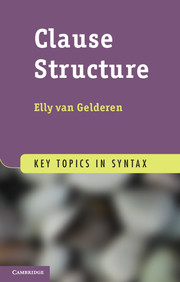2 - The clause: a description
Published online by Cambridge University Press: 05 June 2013
Summary
In this chapter, we’ll discuss the clause in a broad sense. Main clauses can function independently, and we’ll examine what makes them independent. In many languages, this independence is the result of an independent tense. Other factors include a specially marked subject, an overt indication of the mood of the clause, and a complete expression of all the arguments of the verb.
The outline is as follows. In Section 2.1, we examine the basic, minimal components of the simple clause, focusing on English. In Section 2.2, we review semantic, grammatical, and pragmatic functions and roles. Grammatical roles are important for deciding if a clause is embedded or not. In Section 2.3, we explore some of the variety found in English clauses that have more than one lexical verb, i.e. where one is embedded in the other. In Section 2.4, we look at the three layers of the clause and, in Section 2.5, a brief overview of clauses in other languages is provided. Section 2.6 is a conclusion.
THE MAIN CLAUSE
In this section, some characteristics of main clauses are discussed. Main clauses in English have a certain mood, and they need to contain a tensed verb and a subject that agrees with the verb. This set of characteristics anchors an event in place and time and to a speech event, and is known as finiteness. We’ll also put this together in a tree using the familiar CP and TP.
- Type
- Chapter
- Information
- Clause Structure , pp. 39 - 74Publisher: Cambridge University PressPrint publication year: 2013

